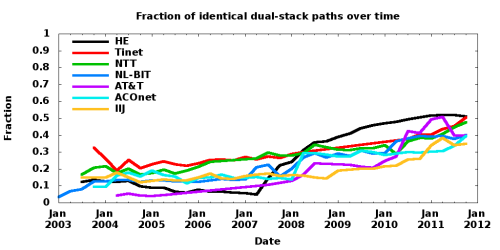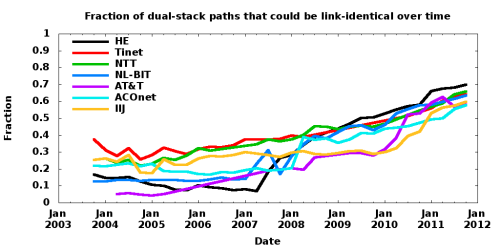IPv6: What could be (but isn’t yet)
June 4th, 2012 by Matthew LuckieWith IPv6 Launch approaching, there is increasing interest in measuring the readiness of the IPv6 infrastructure. A major concern, particularly for networks that source or sink content, is the performance that is achievable over IPv6, and how it compares to the performance over IPv4. A recent study by Nikkah et al. argues that data plane performance, as measured by web page download times, is largely comparable in IPv4 and IPv6, as long as the AS-level paths in IPv4 and IPv6 are identical. We have confirmed these findings with our own measurements covering 593 dual-stack ASes: we found that 79% of paths had IPv6 performance within 10% of IPv4 (or IPv6 had better performance) if the forward AS-level path was the same in both protocols, while only 63% of paths had similar performance if the forward AS-level path was different.
Given the apparent importance of congruent AS-level paths in IPv4 and IPv6, we measured to what extent such congruence exists today, and how this has evolved historically. We measure IPv4 and IPv6 AS paths from seven vantage points (ACOnet/AS1853, IIJ/AS2497, NTT/AS2914, Tinet/AS3257, HE/AS6939, AT&T/AS7018, NL-BIT/AS12859) which have provided BGP data to Routeviews and RIPE RIS since 2003. The figure below plots the fraction of dual-stack paths that are identical in IPv4 and IPv6 from each vantage point over time. According to this metric, IPv6 paths are maturing slowly. In January 2004, 10-20% of paths were the same for IPv4 and IPv6; eight years later, 40-50% of paths are the same for six of the seven vantage points.
Even though the fraction of congruent AS-level paths has been increasing, it is still only around 50%. It is interesting to study the reasons for the divergence. Is it the case that some ASes or AS links from the IPv4 graph are not present in IPv6? How strong could the congruence possibly be, given the set of AS links and ASes from the IPv4 graph that are already present in the IPv6 graph? For each link in an IPv4 AS path toward a dual-stacked origin AS, we examine whether that link is present in the IPv6 topology, regardless of the AS path on which it appears. The figure below shows that currently, 60-70% of AS paths could be link-identical in IPv4 and IPv6 without configuring a new BGP peering session, because for these paths each IPv4 link is already present in the IPv6 topology, just not yet part of an observable BGP-policy-compliant path between the edges.
We take a step further and examine what would happen if each IPv6-capable AS were to establish equivalent peerings in IPv6 and IPv4. For each AS in an IPv4 AS path toward a dual-stacked origin AS, we examine whether that AS is present in the IPv6 topology. The figure below shows the fraction of IPv4 AS paths where each AS on the IPv4 AS path is present in the IPv6 topology. If current IPv6-capable ASes established equivalent peerings in IPv4 and IPv6, 95% of AS paths could be node-identical in IPv4 and IPv6; that is, for an AS link on such a path, both ASes are present in the IPv6 topology, and both ASes already peer in IPv4. If these ASes also started IPv6 peering, we could see the AS paths converge.
These results are encouraging, but they are even more motivating when juxtaposed with the above performance measurements which show IPv4 and IPv6 data plane performance is comparable when the AS paths are the same. Together, these results demonstrate the undeniable benefit of BGP peering parity between IPv4 and IPv6 AS-level topologies.



June 28th, 2012 at 8:32 pm
At one point I started asking customers that had existing ipv4 connectivity and a visible ipv6 path to turn up dual stack on these ports. Many of them were unable to do so as it was just a lab tunnel or their end-to-end network was not v6 capable. I expect this to continue to improve over time.